Goths in Egypt! Visiting Abu Simbel in Aswan, relocated temples of Ramses II. Philae Temple tour.

I heart Egypt!
No Photoshop here… I still can’t believe that I got to see ancient marvels like these all throughout the country.
My 12-day journey with Travel Talk Tours included two ancient temples that were — believe it or not — relocated during the Aswan Dam construction. Let’s wander inside the magnificent Abu Simbel (honoring Pharoah Ramses II), and late period Philae Temple.
Outfit details: Hope heart bag by Lola Ramona, sunhat by Tenth Street Hats, and dress by Jawbreaker Clothing.

Our Travel Talk Tours group tour provided plenty of optional excursions. In Aswan, everyone had the opportunity to add on a morning trip to Abu Simbel. Yukiro and I jumped at this opportunity — it was worth leaving at 3:30am to arrive at Abu Simbel before other tourists.
Although we were sleepy on the ride over, we woke up as soon as we glimpsed this ancient Egyptian monument, carved into the side of a mountain. The immensity of the statues made our jaws drop. (For once, Yukiro is not the tallest person in the photos!)
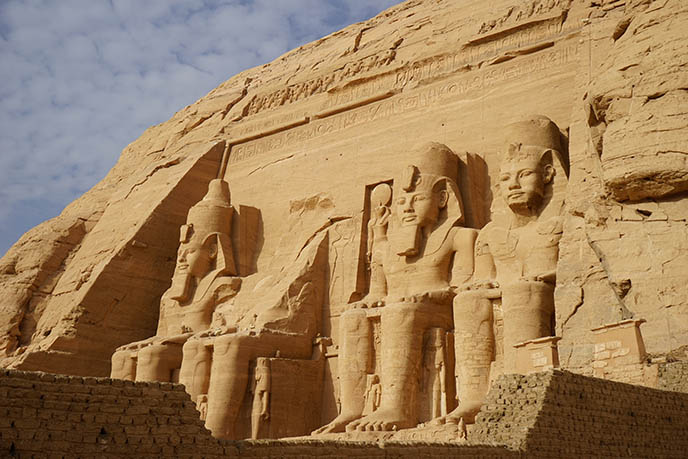
Abu Simbel is located southwest of Aswan, close to the border with Sudan. The main temple is decorated with four gargantuan statues of Ramses II, the most powerful pharaoh of the New Kingdom.

The iconic ruler built several grand temples in Upper Egypt (as the southern region leading to Nubia was known). Ramses II wanted to demonstrate his power in this region, since the Egyptians were continuing to expand into Nubia at the time.
Next to his temple, there’s a smaller but equally impressive Temple of Hathor (above) — dedicated to his queen Nefertari.

Our Travel Talk Tours guide shared the story of how these ancient ruins were discovered. After the fall of Egyptian civilization, the entire complex became buried under sand.
However, in the early 1800s, an Egyptian boy named Abu Simbel stumbled upon one of the statues sticking out of the sand. He led European scholars to the site, and they began to excavate the “lost world.”

Yukiro jumps for joy in front of the Great Temple of Ramesses II. In the 13th century BCE, the two structures were carved out of the mountainside, in an amazing feat of engineering and architecture.

The four kingly statues once overlooked the River Nile. In the 1960s, Abu Simbel was at risk of being submerged during the building of the Aswan High Dam and Lake Nasser.
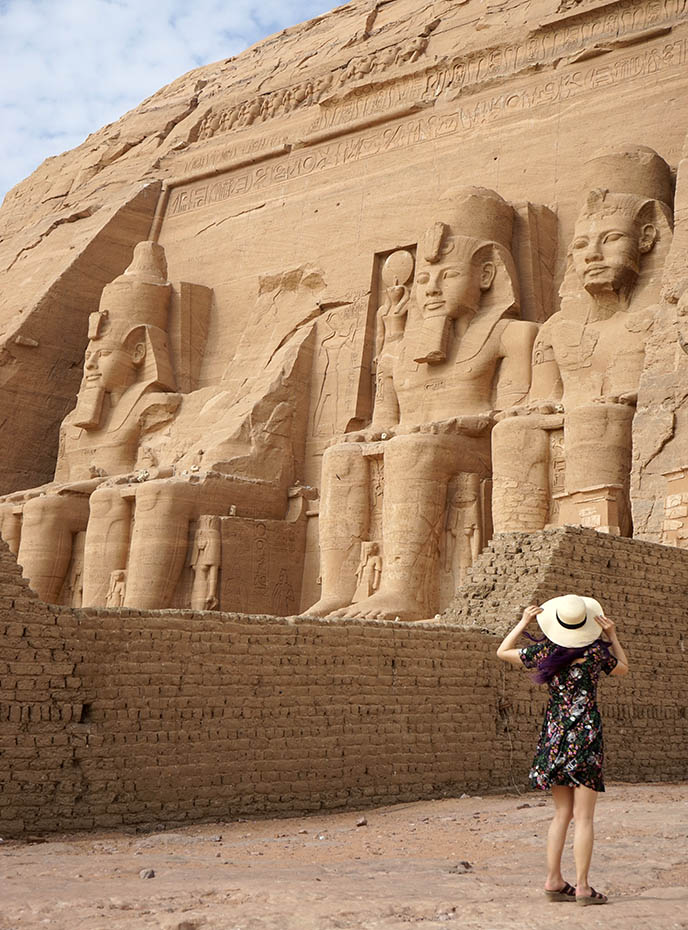
As a result, archaeologists relocated the entire complex to higher ground! From 1964-68, the structure was carefully dismantled, moved, and reassembled nearby.

Appropriately, the key to the temple door is a giant gold ankh! This Egyptian symbol represents the key of life, making it a dramatic entrance to Abu Simbel. (My nails are by Glam Nail Studio in Vancouver.)

It doesn’t get more Goth than this. I’m standing next to a typical “walk like an Egyptian” carving from this period, featuring a profile pose, bent arms, and stiff triangular skirt.

Yukiro and I first went inside the temple for Nefertari, the chief consort of Ramses II. It also honors Hathor, the Egyptian cow-goddess of joy, music, and motherhood.

The pillars featured carvings of ladies in kohl eyeliner and curled hair. This is the second Egyptian temple ever dedicated to a queen (the first, established by Akhenaten, honored his wife Nefertiti).
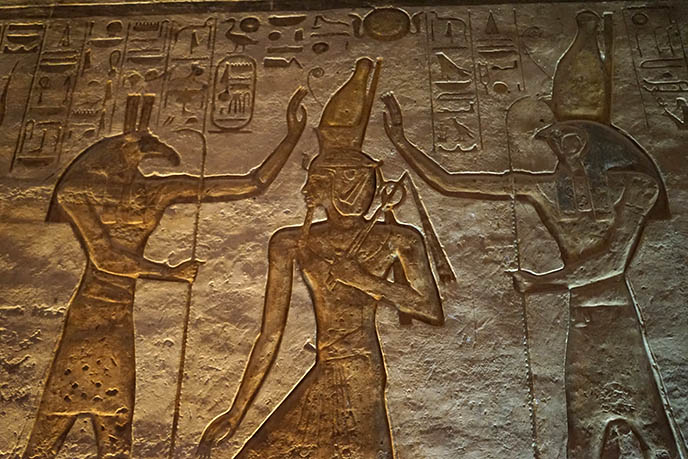
What’s the deal with the “bowling pin hat”?
This unique royal headgear combines the white hedjet crown of Lower Egypt with the red deshret crown of Upper Egypt — symbolizing the pharoah’s rule over the entire country. The bas-relief shows Seth and Horus (the falcon-headed god) crowning Ramses the Second.

The ancient Egyptians were certainly creative with their headpieces. These “bowling pins” and “bunny ears” had symbolic meanings and were associated with different deities.
For example, the central figure is Hathor. She’s depicted with cow horns and a sun in between, representing her bovine and solar powers.

The temples are surprisingly large. You can enter various chambers and tunnels filled with carvings (which made me feel like Lara Croft, Tomb Raider.)

It’s remarkable how well the friezes inside the Great Temples have endured over the millennia.

We loved seeing depictions of queens and goddesses. Here is Nefertari, wearing a plumed or double-feather headdress with a solar disk. She’s flanked by Hathor and Mut, the wife of Amon-Ra.

A pyramid pose for Abu Simbel, which is a UNESCO heritage site and as impressive as the Pyramids of Giza.
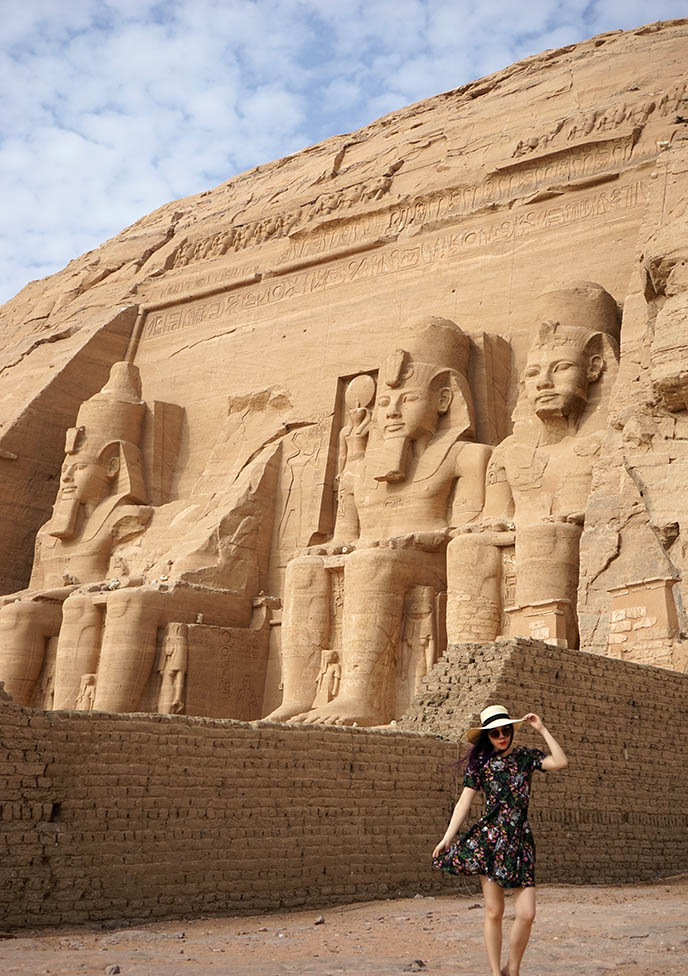
How many head decorations can you count? Ramses II wears the double-crown or pschent, as well as the nemes (a striped headcloth, such as the one worn by King Tut). A uraeus, or coiled serpent, emerges from his forehead to symbolize sovereignty.
Then there’s me, in Tenth Street Hats.

The Temple of Hathor and Nefertari stands out, as the king and his consort are of equal size. (Usually, the wife is depicted smaller.)

Fun fact: Ramses II spawned around 100 children. You can see carvings that represent his other wives and children beneath his seated figures.
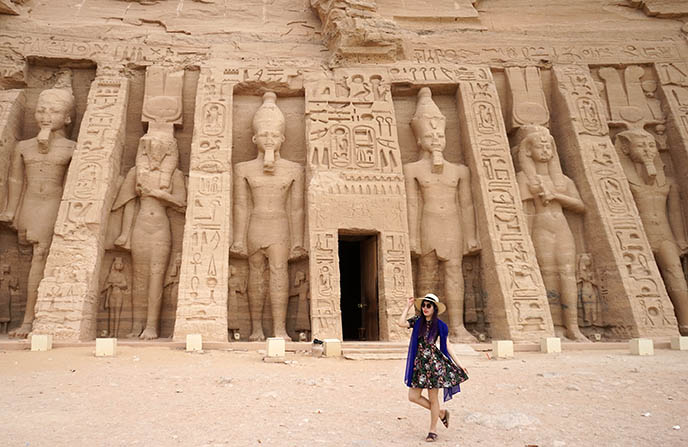
As always, our Travel Talk Tours leader struck a balance in sharing information, and then letting us explore on our own time.
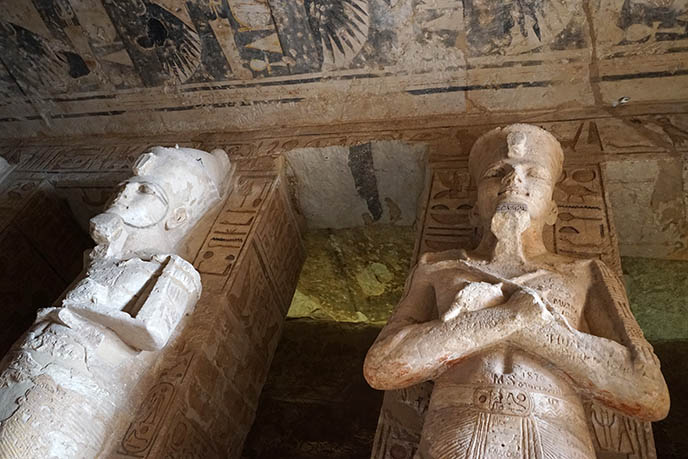
Time to go inside Ramesses II’s temple. It opens into a huge hypostyle hall with eight pillars; they depict the pharoah as Osiris, the god of the Underworld.

In contrast to the queen’s temple, there are many action-packed military carvings here. Ramses II commissioned art to commemorate his victory over the Hittites, in the Battle of Kadesh.

We Goths appreciated the proliferation of ankhs. (This favored symbol represents both mortal existence and the afterlife.)

“Eat the ankh… eat it!”
We were amused to see Egyptian deities placing an ankh against the lips of devotees. This revitalizes the soul and brings them into the afterlife.

Deep inside the main temple, you’ll encounter this spooky sight (no wonder the ancient Egyptians are associated with curses and the occult!) This sanctuary houses four seated divinities: Horakhty, a deified Ramses, Amun-Ra, and Ptah.

Many of the paintings still retain their pigment. The delicate skill of these ancient artists is astonishing.
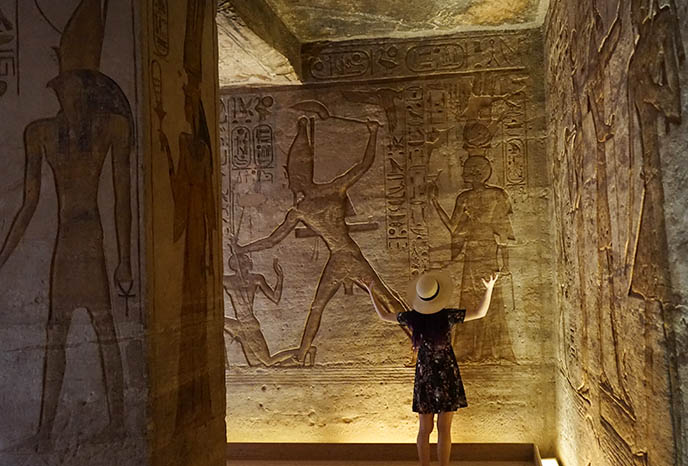
The story of Ramses II’s military victories cover several walls. These bas-reliefs show the Battle of Kadesh, which is probably the largest chariot battle ever fought, with up to 6000 vehicles.

Hail Anubis, the jackal-headed god of mummification and the afterlife. The man without a face probably had his head scratched off by the Christians in a later era…

Hard to believe the majestic Abu Simbel was almost lost to the sands of time. More mysteries of ancient Egypt are revealed every year… I wonder what we might learn next about this fascinating civilization.
Bag Lola Ramona, sunhat Tenth Street Hats, dress Jawbreaker Clothing.
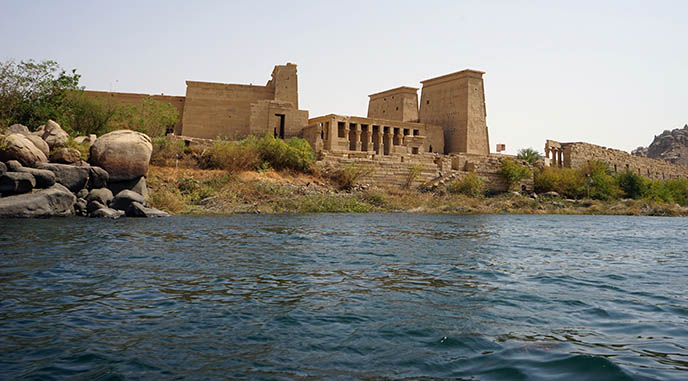
Later that afternoon, Travel Talk Tours took the entire group to Philae Temple (this was one action-packed tour!). We boarded a boat and sailed to Agilkia Island, where Philae now rests. (It also was dismantled and moved here, during the Aswan Low Dam construction).

Philae Temple is dedicated to Isis, the wife of Osiris and mother of Horus. The important goddess helped children and those who were ill, and celebrated life and magic.

Philae Temple was built during the rule of the Greek Ptolemies (around 380–362 BCE). This was the final Egyptian dynasty, which ended with the death of Queen Cleopatra VII.
Isis’ temple features a grand pylon entrance carved with deities. Philae was probably the last active site of the ancient Egyptian religion, which disappeared after the end of the Ptolemy era.

As Philae was built in Hellenistic times, you can see the Greco-Roman influence in the architecture. I’m standing in the gateway of Trajan’s Kiosk, a hypaethral (open-roof) temple made by the Roman Emperor, Trajan.

Such a fascinating combination of Greco-Roman and New Kingdom Egyptian art. The ladies look a bit like the ones in Nefertari’s temple, but this one is sticking her tongue out!

Some parts of Philae Temple look straight out of Greece or Rome, such as this long flank of fluted columns.

Inside Philae Temple, you’ll encounter a hypostyle hall, and chambers dedicated to other deities like Hathor.

As you can see, Egyptian art looks different in this late era of the civilization. The headdresses, poses, and hieroglyphics are similar to what you’ll see in Abu Simbel and Karnak…

… however, the bodies are more voluptuous, and the carving style is dissimilar (look at the hair and finger detail for example). Here’s a close-up of Sekhmet, the lion head goddess, holding an ankh.

This beautiful relief shows goddess Isis protecting her husband Osiris with outspread wings. A pharaoh (identifiable by his bowling pin crown) offers a libation to the gods.

We learned so much about Egypt’s history throughout the tour. Not everyone knows that the final rulers descended from Ptolemy (including the famed Cleopatra) were ethnically Greek. They built temples like this to placate the Egyptian population, and legitimize their rule.

After Cleopatra and Mark Antony died, Egypt became a Roman province ruled under Octavian. Egypt would no longer be ruled by its own people until the 20th century.
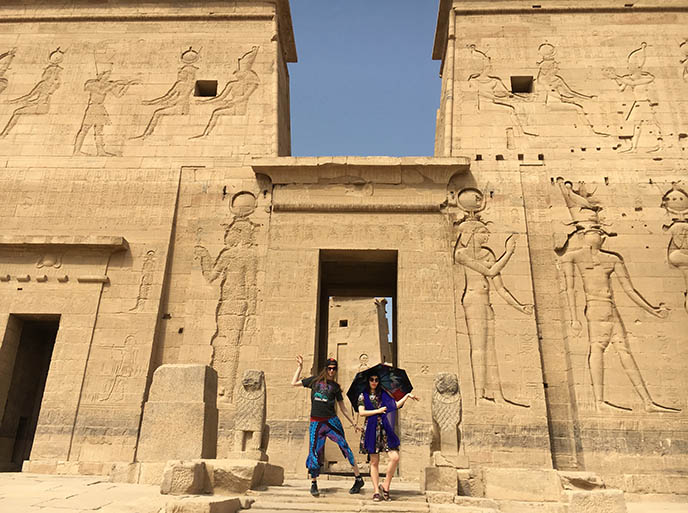
Egypt is everything I look for in a destination. Yukiro and I were glad we got to travel safely and see so much of the country, thanks to Travel Talk Tours.
Where am I off to next? Announcement to come soon, so stay tuned and check out my Instagram @lacarmina for regular updates!
SHARE & COMMENT

 LA CARMINA
LA CARMINA








4 Comments
Egypt is amazing. Was there exactly 15 years ago this week. It takes your breathe away to see Abu Simbel and the temples.
These photos (and those buildings) are spectacular! You must have had such a fantastic trip!
I would love this kind of tour soooo much!!
Oh my gosh, so many interesting facts here. wow, such a stunning place & you photograph it so well. Thanks for the creative post!
Great Article. Love reading it. Thanks for sharing.